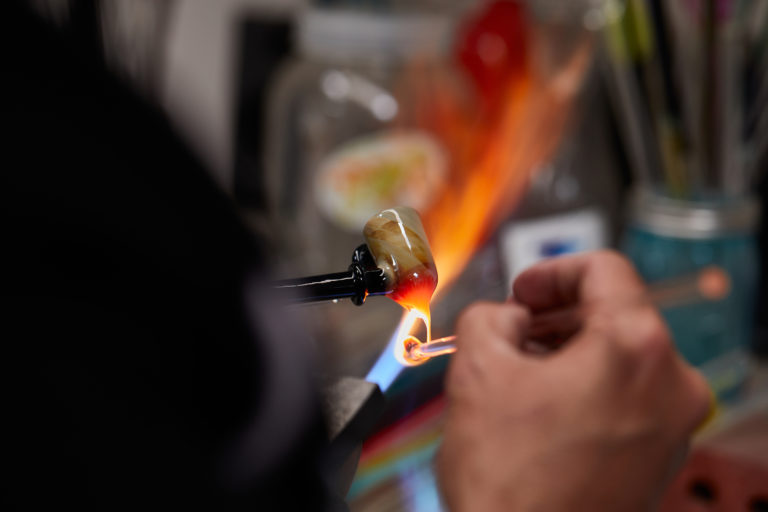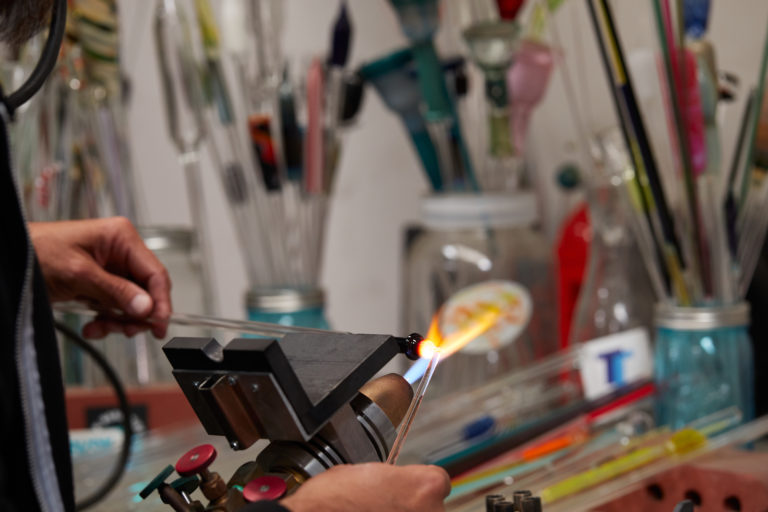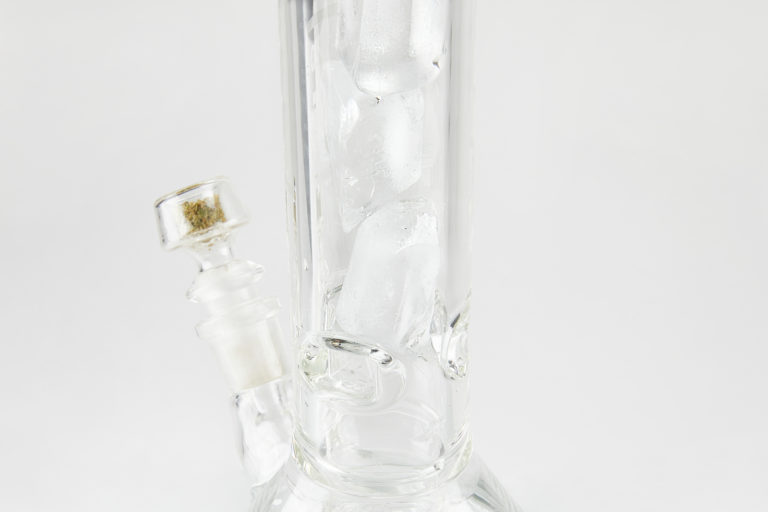Bongs are made using the core techniques of glass blowing. What makes bongs unique, however, is their complexity compared to other glass smoking devices. Bongs often feature bright colors, intricate designs, and elaborate decorations. Similarly, many bongs come with additional components such as ice catchers and percolators. All of this adds up to a very interesting — and impressive — glass-making process. Here's how bongs are made.
The basics
Step 1: Forming the Water Chamber
As with most other glass weed pipes, glass blowers start out with a long thin tube of glass. The first step in making a bong is generally to form the water chamber, as this also serves as the base for the entire pipe.
The glass blower uses a blowtorch to apply heat to the glass tubing. This expands the glass into a much larger cylinder. Using a hollow steel pipe or a tool called a blowpipe, the artist then blows air into the hot glass, making it bulge up into a large, bulbous bubble. While blowing into the glass, the artist must continually rotate the glass tubing to ensure that the expanded base does not become lopsided or uneven.
 Photo by: Gina Coleman/Weedmaps
Photo by: Gina Coleman/WeedmapsImage lightbox

While the glass remains hot, the blower shapes the chamber until it reaches the desired size and shape. When the water chamber has been shaped, the artist uses a special tool to punch a hole in the side of the chamber. This is eventually where the downstem will fit.
Step 2: Making the Neck
The glass blower then applies heat to the glass tubing directly above the water chamber. As this part of the tubing expands into a larger cylinder, the blower again keeps the entire thing rotating smoothly and evenly. Often, a lathe is used to keep the cylinder perfectly uniform. The glass blower will continue this process until they achieve a cylinder long and wide enough to serve as the neck of the bong.
 Photo by: Gina Coleman/Weedmaps
Photo by: Gina Coleman/WeedmapsImage lightbox

Step 3: Shaping the Mouthpiece
Now that the neck of the bong now successfully formed, the glass blower focuses on shaping the mouthpiece, located at the very top of the neck.
To do this, they again apply heat to make the glass malleable. From there, they begin separating the widened neck from the remainder of the initial glass tubing. When the neck breaks free from the tubing, the artist rotates the pipe to maintain a uniform shape and size and then carefully smoothes the top of the neck into a mouthpiece, ensuring that there are no sharp edges.
Step 4: Downstem and Bowl
Most bongs use removable downstems and bowls, which requires the glass blower to make these components in addition to the bong itself. These pieces are made using same glass-blowing techniques used to create the bong: heating glass tubing until it becomes malleable and using a combination of spinning, blowing, and tools to widen, shape, and otherwise manipulate the hot glass.
 Photo by: Gina Coleman/Weedmaps
Photo by: Gina Coleman/WeedmapsImage lightbox

Obviously, the downstem and bowl will have much smaller diameters and openings than the bong itself. The downstem should fit snugly inside the hole punched into the side of the water chamber. Similarly, the bowl must be the right size to slide easily in and out of the downstem.
The art of glass bongs: Style and decoration
One of the things that make glass bongs unique is that they also function as art. In fact, some high end glass blowers make incredibly intricate and artful bongs that carry price tags over six figures. Even more affordable pieces often include stylistic and artistic elements, typically in the form of colors, etching, or by making the bong into a unique shape.
 Photo by: Gina Coleman/Weedmaps
Photo by: Gina Coleman/WeedmapsImage lightbox

Some glass blowers add color by melting chunks of colored pigment or glass into the main tubing being used to make a bong. As the artist forms the pipe, they can stretch and manipulate these flecks of color into different lines and patterns.
Alternatively, artists add color to glass through a process called “fuming.” The technique involves vaporizing certain types of metal — often silver, gold, or platinum — and passing that vapor through the initial glass tubing. This process coats the inside of the tubing with the metal so that as the artist transforms the initial tubing into the bong, those streaks of metal stretch and transform into interesting streaks of color.
 Photo by: Gina Coleman/Weedmaps
Photo by: Gina Coleman/WeedmapsImage lightbox

Along with color, glass blowers often add molten glass to the exterior of the bong, creating mini sculptures or designs on the outside of the piece. The bong itself can be made into whatever shape the artist imagines — as long as it maintains a water chamber, neck, mouthpiece, and an opening for downstem and bowl.
Machine-made bongs
While this guide has focused on traditional, hand-made glass bongs, machine-made, mass-produced bongs are also incredibly common in today's market. These bongs are made through more or less the same technique of applying heat to make glass malleable and shaping the hot glass through a process of spinning, molding, and blowing air.
Bong accessories
Glass bongs are more than effective and beautiful smoking pieces — also they provide versatility, allowing you to add other components and accessories to improve your smoking experience. These include attachments like:
Ice catcher
A circular tray with holes in it that fits inside the main neck of a bong, designed to hold ice cubes. The ice cools the smoke, giving you an extra-smooth hit.
 Photo by: Gina Coleman/Weedmaps
Photo by: Gina Coleman/WeedmapsImage lightbox

Percolator
Percolators come in a wide variety of styles, shapes, and sizes, but they all feature an array of holes designed to create tons of bubbling action when you pull smoke through the water chamber. The numerous tiny bubbles created by a percolator add filtration for incredibly smooth, cool, and tasty smoke.
 Photo by: Gina Coleman/Weedmaps
Photo by: Gina Coleman/WeedmapsImage lightbox

In general, these and other similar bong accessories are also made out of glass and created through the same glass-blowing process as a bong.

